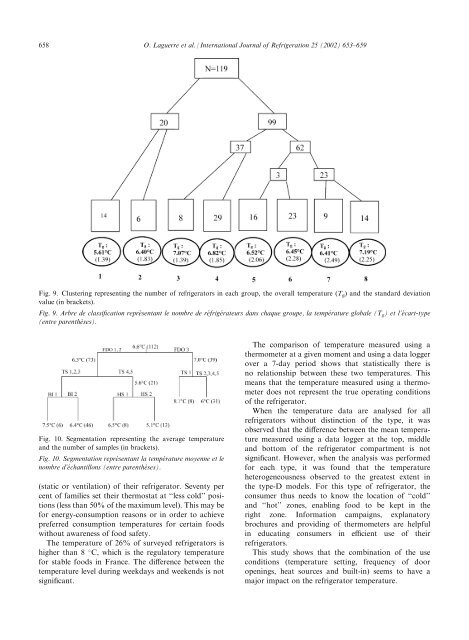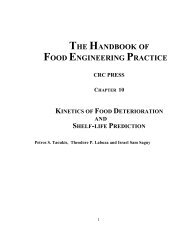Study of domestic refrigerator temperature and analysis of ... - SMAS
Study of domestic refrigerator temperature and analysis of ... - SMAS
Study of domestic refrigerator temperature and analysis of ... - SMAS
You also want an ePaper? Increase the reach of your titles
YUMPU automatically turns print PDFs into web optimized ePapers that Google loves.
658 O. Laguerre et al. / International Journal <strong>of</strong> Refrigeration 25 (2002) 653–659<br />
Fig. 9. Clustering representing the number <strong>of</strong> <strong>refrigerator</strong>s in each group, the overall <strong>temperature</strong> (Tg) <strong>and</strong> the st<strong>and</strong>ard deviation<br />
value (in brackets).<br />
Fig. 9. Arbre de classification représentant le nombre de réfrigérateurs dans chaque groupe, la température globale (Tg) et l’écart-type<br />
(entre parenthèses).<br />
Fig. 10. Segmentation representing the average <strong>temperature</strong><br />
<strong>and</strong> the number <strong>of</strong> samples (in brackets).<br />
Fig. 10. Segmentation représentant la température moyenne et le<br />
nombre d’échantillons (entre parenthèses).<br />
(static or ventilation) <strong>of</strong> their <strong>refrigerator</strong>. Seventy per<br />
cent <strong>of</strong> families set their thermostat at ‘‘less cold’’ positions<br />
(less than 50% <strong>of</strong> the maximum level). This may be<br />
for energy-consumption reasons or in order to achieve<br />
preferred consumption <strong>temperature</strong>s for certain foods<br />
without awareness <strong>of</strong> food safety.<br />
The <strong>temperature</strong> <strong>of</strong> 26% <strong>of</strong> surveyed <strong>refrigerator</strong>s is<br />
higher than 8 C, which is the regulatory <strong>temperature</strong><br />
for stable foods in France. The difference between the<br />
<strong>temperature</strong> level during weekdays <strong>and</strong> weekends is not<br />
significant.<br />
The comparison <strong>of</strong> <strong>temperature</strong> measured using a<br />
thermometer at a given moment <strong>and</strong> using a data logger<br />
over a 7-day period shows that statistically there is<br />
no relationship between these two <strong>temperature</strong>s. This<br />
means that the <strong>temperature</strong> measured using a thermometer<br />
does not represent the true operating conditions<br />
<strong>of</strong> the <strong>refrigerator</strong>.<br />
When the <strong>temperature</strong> data are analysed for all<br />
<strong>refrigerator</strong>s without distinction <strong>of</strong> the type, it was<br />
observed that the difference between the mean <strong>temperature</strong><br />
measured using a data logger at the top, middle<br />
<strong>and</strong> bottom <strong>of</strong> the <strong>refrigerator</strong> compartment is not<br />
significant. However, when the <strong>analysis</strong> was performed<br />
for each type, it was found that the <strong>temperature</strong><br />
heterogeneousness observed to the greatest extent in<br />
the type-D models. For this type <strong>of</strong> <strong>refrigerator</strong>, the<br />
consumer thus needs to know the location <strong>of</strong> ‘‘cold’’<br />
<strong>and</strong> ‘‘hot’’ zones, enabling food to be kept in the<br />
right zone. Information campaigns, explanatory<br />
brochures <strong>and</strong> providing <strong>of</strong> thermometers are helpful<br />
in educating consumers in efficient use <strong>of</strong> their<br />
<strong>refrigerator</strong>s.<br />
This study shows that the combination <strong>of</strong> the use<br />
conditions (<strong>temperature</strong> setting, frequency <strong>of</strong> door<br />
openings, heat sources <strong>and</strong> built-in) seems to have a<br />
major impact on the <strong>refrigerator</strong> <strong>temperature</strong>.














